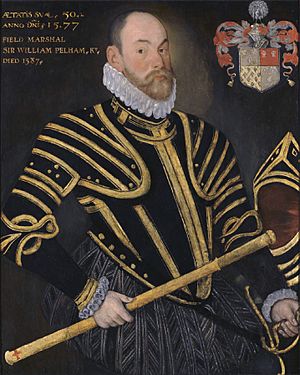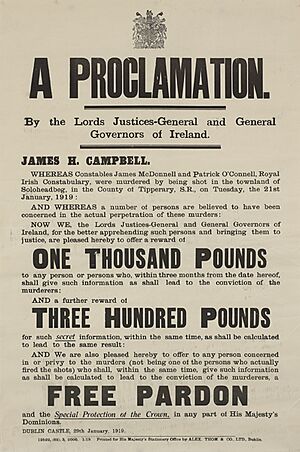Lords Justices of Ireland facts for kids

The Lords Justices were important officials in Ireland who acted as temporary leaders when the main governor, like the Lord Lieutenant, was away. They were also known as the "Lords Justices General and General Governors of Ireland." Think of them as a team of stand-in leaders for the government in Dublin Castle. They were officially sworn into their roles at a meeting of the Privy Council of Ireland, which was a group of advisors to the King or Queen.
History of the Lords Justices
After the Norman Conquest of Ireland, the King of England appointed the main governor of Ireland. This governor could sometimes choose a deputy. If the governor died, the Irish Privy Council would pick someone to take over until the King chose a new one. The title of the main governor changed over time, depending on how much power they had. Titles included King's Lieutenant, Lord Deputy, or Justiciar. A deputy would always have a lower title.

In the 1600s, the King often left the main governor's position empty for months or even years. Instead, several Lords Justices were appointed to run things. This happened almost continuously from 1690 to 1700. Before 1767, the main governor (called the Lord Lieutenant or viceroy) was often in England, only coming to Ireland when the Parliament of Ireland was meeting.
The Lords Justices were usually Irishmen, while the Lord Lieutenant was often a British noble. This meant the Lords Justices had a lot of influence, and the English government needed their support. There were usually three Lords Justices. They were often the Speaker of the Irish House of Commons, another member of the Irish Parliament, and a senior bishop from the Church of Ireland. After 1767, the viceroy usually lived in Ireland, so the Lords Justices became less important day-to-day. However, they were still needed when there was a gap between one viceroy leaving and a new one arriving.
After the Acts of Union 1800, which joined Ireland with Great Britain, the real power shifted from the viceroy to the Chief Secretary for Ireland. The Lords Justices, like the viceroy, mostly had formal duties. When a new Lord Lieutenant arrived, the Lords Justices would officially hand over the "sword of state," a symbol of authority.
Until the mid-1800s, the usual Lords Justices were the Lord Chancellor, the Church of Ireland Archbishop of Armagh or of Dublin, and the Commander-in-Chief, Ireland. After the Church of Ireland was no longer the official state church in 1871, bishops were no longer appointed as Lords Justices. Usually, only two were sworn in, or the third was another senior judge.
As the 1800s continued, Lords Justices were appointed more often for short periods when the Lord Lieutenant was away from Dublin. This helped to avoid delays in making official decisions for everyday government tasks. For example, between 1890 and 1921, the Lord Lieutenant was away about eight times a year, sometimes for days, sometimes for over a month. During these times, various judges and other important figures would step in as Lords Justices.
During the Irish revolutionary period, there was a suggestion to replace the Lord Lieutenant with three Lords Justices during the Conscription Crisis of 1918. However, they couldn't find three people willing to take on the role.
After the Anglo-Irish Treaty and the partition of Ireland, the role of Lord Lieutenant of Ireland was ended in 1922. It was replaced by the Governor-General of the Irish Free State in the south and the Governor of Northern Ireland in the north. Northern Ireland's governor had deputies chosen by their Privy Council. The Irish Free State didn't have a privy council, and the Chief Justice was meant to be the stand-in for the Governor-General, but this never actually happened.
List of Lords Justices (Examples)
Over the centuries, many important people served as Lords Justices. They were often high-ranking officials like the Lord Chancellor (a top legal officer), military commanders, or senior judges. Sometimes, important members of the Irish Parliament or even archbishops were chosen.
For example, in the 1600s, people like Sir Thomas Cusack and William Pelham served. Later, in the 1700s, figures such as Henri de Massue, Earl of Galway and Hugh Boulter, the Archbishop of Armagh, took on the role. In the 1800s and early 1900s, it was common for the Lord Chancellor, the Commander-in-Chief of the army, and senior judges to be the Lords Justices.
See also
- Presidential Commission (Ireland), three officials who collectively deputise for the President of Ireland
- Regency Acts provide for a regent during a monarch's total incapacity
- Counsellor of State during partial incapacity, such as when abroad
- Lords Commissioners for routine Parliamentary functions
- Governor of Northern Ireland#Deputies § Notes
Sources
- I: 1603–1642; II: 1642–1660; III: 1660–1690

